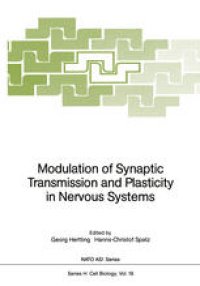
Ebook: Modulation of Synaptic Transmission and Plasticity in Nervous Systems
- Tags: Neurosciences, Cell Biology, Anthropology, Pathology, Human Physiology, Pharmacology/Toxicology
- Series: NATO ASI Series 19
- Year: 1988
- Publisher: Springer-Verlag Berlin Heidelberg
- Edition: 1
- Language: English
- pdf
This volume is based on a workshop "Modulation of Synaptic Transmission and Plasticity in Nervous Systems" held in n Ciocco, Castelvecchio, Pascoli, Italy, from September 8th to 13th, 1987. The purpose of the meeting was to bring together scientists working on plasticity in nervous systems on different levels. The contributions can be subgrouped into six fields of research: 1) Presynaptic Modulation of Chemical Neurotransmission 2) Postsynaptic Signal Transduction 3) Modulation of Synaptic Transmission and Plasticity in the Hippocampus 4) Modulation of Neuromuscular Transmission 5) Molecular and Cellular Analysis of Conditioning in Marine Snails 6) Analysis of Learning and Memory in Insects Understanding how nervous systems and in particular our brain processes and stores information has been a major challenge in science for centuries and will remain for some time to come. Not until recently neurobiologists agreed to seek plasticity of behavior primarily in the modulation of the properties of synapses between nerve cells. This is to be understood within the context provided by a neural circuitry. An important stimulus came from the work on the marine snail Aplysia, where learning processes can be described as a modulation of transmitter release, traced back to a complete chain of molecular events in an identified neuron. Learning became a topic of molecular biology. Three systems appear particularly promising for this approach: insects, in particular Drosophila, marine snails and the mammalian hippocampal tissue. Our views on neurotransmission have rapidly changed.
To understand how information is processed and stored by the nervous system, and in particular the human brain, has been a major challenge in science for centuries and will remain so for some time to come. Not until recently did neurobiologists agree to seek plasticity of behavior primarily in the modulation of the properties of synapses between nerve cells. This must be understood within the context provided by a neural circuitry. Learning has become a topic of molecular biology. Three systems appear particularly promising for this approach: Drosophila, the marine snails Aplysia and Hermissenda, and the mammalian hippocampal tissue.
To understand how information is processed and stored by the nervous system, and in particular the human brain, has been a major challenge in science for centuries and will remain so for some time to come. Not until recently did neurobiologists agree to seek plasticity of behavior primarily in the modulation of the properties of synapses between nerve cells. This must be understood within the context provided by a neural circuitry. Learning has become a topic of molecular biology. Three systems appear particularly promising for this approach: Drosophila, the marine snails Aplysia and Hermissenda, and the mammalian hippocampal tissue.
Content:
Front Matter....Pages I-X
Presynaptic Modulation of Chemical Neurotransmission: The Blood Vessel Paradigm....Pages 1-3
Modulation of Purine Release from Electrically-Stimulated Cortical Slices of the Rat: Interaction with the Cholinergic System....Pages 5-24
Modulation of Glutamate and Gaba Release by Excitatory Amino Acid Receptor Agonists in Cultured Cerebellar Cells....Pages 25-37
Serotonin-Glutamate Interactions in Rat Cerebellum: Involvement of Multiple 5-HT Receptor Subtypes....Pages 39-53
Modulation of Transmitter Release by Presynaptic Serotonin Receptors....Pages 55-68
Opioid Peptides, Opioid Receptors and Modulation of Catecholaminergic Neurotransmission Processes in the Central Nervous System....Pages 69-83
Noradrenergic Modulation of Acetylcholine Release....Pages 85-98
Control of Acetylcholine Release and of Intestinal Motility by Subtypes of Muscarine Receptors....Pages 99-110
Cholinergic-Adrenergic Presynaptic Interactions on the Heart in the Millisecond Range as Studied With the Pulse-to-Pulse Method....Pages 111-125
New Aspects on Modulation Of Sympathetic Neurotransmission: by Change of Probability of Secretion of Single Mixed Quanta From Two Classes of Nerve Varicosities....Pages 127-146
Participation of Regulatory G-Proteins and Protein Kinase C in the Modulation of Transmitter Release in Hippocampus....Pages 147-164
Attempts to Characterise Dopamine Receptor-Effector Mechanisms in the Brain....Pages 165-174
Postsynaptic Signal Transduction in Neuroblastoma and Ganglion Cells: Receptor-Mediated Control of K-Currents....Pages 175-185
Neurotransmitters, Ion Channels and Second Messengers in the Hippocampus....Pages 187-200
A Family Of Neurotransmitter Receptors Couple to a Potassium Conductance....Pages 201-212
Induction and Maintenance of Long-Term Potentiation in the Hippocampus....Pages 213-225
Initiation of Long-Term Potentiation: Dependency on Parameters of Stimulation and External Calcium....Pages 227-233
The Role of Protein Phosphorylation in Long-Term Potentiation....Pages 235-248
A Possible Role for Ependymin in Hippocampal Plasticity....Pages 249-257
Modulation of Quantal Synaptic Release by Serotonin and Forskolin in Crayfish Motor Nerve Terminals....Pages 259-270
Neurotransmitter-Induced Regulation of Voltage-Dependent Calcium Current in Identified Snail Neurons....Pages 271-288
Modulation of Neuromuscular Transmission in the Locust by Fmrfamide-Like Peptides....Pages 289-304
Constancy and Plasticity in the Operation of the Motor Control System for Locust Flight....Pages 305-318
Neuropharmacology of Learning and Memory in Honey Bees....Pages 319-332
Habituation and Sensitization of the Landing Response of Drosophila Melanogaster: II. Receptive Field Size of Habituating Units....Pages 333-350
Molecular Aspects of Plasticity in Phototaxis....Pages 351-368
Short-Term Persistence of Sexual Arousal in Drosophila Melanogaster Males: Contrasting Behavioural Expression in Two Wild-Type Strains....Pages 369-385
Gene Strategy in the Modulation of Synaptic Activity....Pages 387-400
Back Matter....Pages 401-417
....Pages 419-432